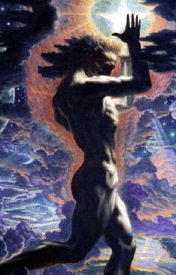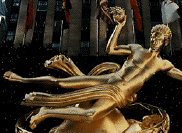|
The 20th Century Alexander Scriaben composed his "Prometheus, Le Poeme du feu" (Poem of the Fire) in 1908. Samual Barber pens his "Incidental Music for a Scene from Shelley" in 1933. Thus, in the 20th Century, Prometheus continues to live in music as well as words and images--and everywhere else. A rare Earth metal is named after him; a moon of Saturn; a mountain in Nevada; a dozen sites on the Internet. Nothing surprising there. What is interesting, however, is that a couple of trends have become apparent. First, although all three themes appear from classical to modern times, they do not appear in equal numbers. Creation, perhaps lacking the conflict of the other two themes, was at its most popular during the classical age (not surprisingly, since what I am here terming Ancient Greek "legend" is quite rightly termed Ancient Greek "religion" elsewhere). No doubt the advent of Christianity helped diminish popular interest in the creation theme, while at the same time boosting interest in the torment theme. Torment dominated Promethean art and literature from the Renaissance to the dawn of the 20th Century, when suddenly the fire-theft theme came into its own.
Fire-theft. Prometheus. Jean Delville, 1907.
Fire-theft. Frieze on AT&T Building in NYC.
Second, Prometheus has quite clearly gotten a lot younger as the centuries have ticked by. The beard is gone, so too the big muscles, and, in a couple of treatments, the mighty Titan is portrayed as positively boyish--a trend no doubt strengthened by the famous art deco statue in Rockefeller Plaza. There are a dozen such 20th Century examples of a cupid-like Prometheus bearing his torch, including the campy (if you know the legend) Maxfield Parrish calendar for Edison Electric. If Aeschylus were inclined to roll over in his Athenian grave, this would certainly do the trick.
Fire theft. Prometheus, Paul Manship, 1934,
Fire-theft. Prometheus, Maxfield Parrish (detail from an Edison calendar), c. 1930.
To return, in closing, to the rise of the fire-theft theme, may I suggest that in today's Information Age, the idea of taking knowledge from those who would hoard it and giving it freely to all humanity, is bound to be popular.
Fire, as a symbol of enlightenment, has lost nothing over the millennia; indeed it reinvents itself with every age. Today, the name "Prometheus" means little or nothing to most of us. But if we see a statue of a man holding up a torch in front of a university, we get his point, though we may not know his name. To be sure, the theft element seems to be spliting off from the theme, leaving the idea of fire not stolen, but preserved; passed on; kept alight.
Fire-theft. Wisdom, Tseretel, 1990,
Thus, in a modern act of deconstruction, the Prometheus Legend has been reduced to the simplest form of graphic metaphor: the logo--a hand holding a burning torch--and then reduced again, to just the torch, and finally, just the flame. Various logos associated with the name Prometheus.
|

